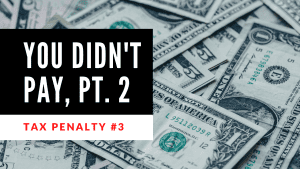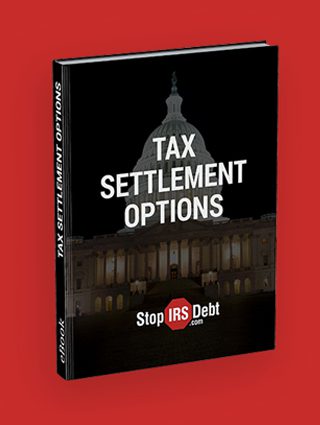- browse by category
- Audit Assistance
- Business and Taxes
- Celebrities in Tax Debt
- Cryptocurrency Taxes
- Economic News
- Foreign Banking
- Innocent Spouse
- IRS Headlines
- IRS Wage Garnishment
- Marriage & Divorce
- Payroll Tax
- Retirement
- Revenue Officers
- State Tax Headlines
- Stop IRS Debt
- Success Stories
- Tax and Politics
- Tax Attorney
- Tax Codes
- Tax Debt Help
- Tax Evasion
- Tax Levy
- Tax Lien
- Tax Payment Plans
- Tax Return Filing
- Tax Tips

The IRS always gets its money. Always. Whether we like it or not, some portion of our income will skip right past our wallets and head directly to Uncle Sam. When it doesn’t, that’s when we find ourselves slapped with a tax bill. Sadly, there are countless causes of tax debt. But easily the most insidious of these causes is one of the most easily avoidable: tax penalties.
Tax debt is bad enough, but tax penalties supercharge it. They can transform a modest tax bill into a massive one. And left unchecked and untended to, IRS penalties have derailed the financial plans of millions of hardworking taxpayers. They’ve been (at least) partially responsible for drained bank accounts, wage garnishments, tax liens, and worse.
If you’re facing IRS debt, tax penalties have the potential to cause your total to balloon—a lot faster than you may realize.
As a full-service tax representation firm, we’ve seen first hand how detrimental and outright dangerous tax penalties can be. They can make your work climbing out of tax debt and getting your life back a whole lot more challenging. Because not only are they designed to keep piling up until you pay the IRS. But also, frankly, most people just don’t know much about IRS penalties in the first place.
And it’s hard to win a battle against an enemy you don’t understand.
We think it’s important to clear up the confusion—once and for all. We’re going to give you every last piece of information about tax penalties that you’ll ever need to know. We’ll walk you through the tax penalty basics, the different types of IRS penalties, how you can avoid them. Then, we’ll answer some of the most popular FAQs about tax penalties we get from our clients.
What are IRS penalties?
IRS penalties are pretty similar to most other kinds of penalties out there associated with your bank, the video rental store, or the library. When you overdraft your debit account, you may get charged a penalty of $20. Or if you fail to return that Blu-ray to the rental store or that book to the library on time, they may hit your account with a late fee.
IRS penalties aren’t that much different than any other kind of penalty you’ve experienced.
The IRS has a set of rules they want you to play by. These rules really boil down to two things: pay your taxes on time, and file your taxes on time. When you don’t check either of those boxes, you may encounter a tax penalty. (Of course, the exact penalty may differ.)
So, let’s take a look at the different types of penalties.
Types of Tax Penalties
Of course, it wouldn’t be the IRS if it were simple. There are literally dozens of tax penalties out there of one flavor or another, which can apply to all sorts of infractions, minor to major. But the vast majority of taxpayers will only ever deal with the four most common penalties.
1. Failure to File
The IRS charges you a failure to file penalty when you don’t file your tax return by the return due date, which is typically April 15 unless stated otherwise by the IRS. If you filed for an extension and that extension was approved, the IRS will charge you a failure to file penalty if you don’t file your tax return by the extended due date (which is usually October 15, six months after Tax Day).
2. Failure to Pay
At tax time, you know the drill: You either owe the IRS money, or the IRS owes you a refund. When you owe the IRS, you need to pay them by the due date. If you don’t pay the taxes reported on your return—in full—by the due date (usually April 15), the IRS will charge you a failure to pay penalty.
An important note: Requesting an extension to file does not give you more time to pay your taxes. They’re always due on Tax Day.
3. Failure to Pay Proper Estimated Tax
When you don’t have an employer to regularly withhold your taxes on your behalf, you have to do it yourself. That’s why self-employed taxpayers have to estimate their taxes and make quarterly payments to the IRS. However, those with employers can still underestimate their taxes and end up withholding less than they should—which results in a tax bill. When you don’t pay enough taxes due for the year with your quarterly estimated tax payments—or through withholding—the IRS can charge you a penalty.
4. Dishonored Check
This penalty is probably the easiest of the bunch to parse out. If you owe the IRS money, there really aren’t too many methods of paying them. If your check bounces or if whatever method of payment you use when paying your tax bill is declined, the IRS will apply this penalty to your account.
How does the IRS calculate penalties?
Much like the numerous ways you can get slapped with an IRS penalty, each of these tax penalties carries its own specific implication on your tax bill. And knowing what each penalty actually means for your account is the first step to figuring out how to start fighting back against your tax debt.
So, here’s what the four most common tax penalties do when applied to your tax bill.
1. Failure to File

Penalty: 5% of unpaid tax required to be reported.
Frequency: Monthly. It applies each month or part of a month the return is late, up to 5 months.
Kicks In: Immediately. Itapplies for a full month, even if the return is filed less than 30 days late.
Additional Penalties: Your return is subject to a minimum late filing penalty when you file more than 60 days after the due date (or extension date). The minimum is the lesser of two amounts: 100% of the tax shown on the return that you didn’t pay on time, or a specific dollar amount, adjusted for inflation. As of 2020, the total was $435 but you can find the full list here.
Example (5 Days Late): You just missed the tax deadline! If you owed $1000 in taxes to the IRS, since you failed to pay or file your tax return, you’re going to get hit with a Failure to File penalty. Fortunately, you won’t be racking up these penalties for multiple months! However, you’re still on the hook for $50 in penalties. Your new tax bill is $1050. (But that will be accompanied by a Failure to Pay penalty.)
Example: (65 Days Late): For whatever reason, you didn’t file your tax return until mid- to late-June. And now you have to deal with some serious tax penalties. On your $1000 bill, your Failure to File penalty is now $150. And because you filed more than 60 days after the due date, you’re going to be adding $435. Your new tax bill is $1585. (And that will be accompanied by Failure to Pay penalties.)
2. Failure to Pay (Reported and Not Reported on Tax Return)

There are two ways you can fail to pay your taxes, and which category you fall into depends on whether you reported that tax on your return or not. Remember, you’re on the hook for your taxes, whether or not you report them on your tax return.
Penalty (Reported): 0.5% of tax not paid by Tax Day; 0.25% during an approved installment agreement; 1% if tax isn’t paid within 10 days of a levy notice.
Penalty (Not Reported): 0.5% of tax not paid by the due date in notice (usually 21 days, or 10 days for totals of over $100,000); 0.25% during approved installment agreement; 1% iftax isn’t paid within 10 days of a levy notice.
Frequency (Reported): Monthly, even if it’s only part of a month, until the tax is paid or 25% is reached.
Frequency (Not Reported): Monthly, even if it’s only part of a month, until the tax is paid in full.
Kicks In (Reported): Immediately after the due date, and applies for the full month even if the tax is paid before then.
Kicks In (Not Reported): Immediately after the due date passes.
Additional Penalties: None.
Example (5 Days Late): You filed your tax return but you didn’t make payment on your tax bill. So, the IRS will slap you with a penalty of 0.5%, totaling $5. Your new total is $1005.
Example: (65 Days Late): You filed your tax return but didn’t make full payment until just over 2 months later. The IRS slaps you with a monthly penalty of 0.5% until you pay your $1000 balance in full. For two months and a partial month, you’ve tacked $15 onto your tax bill. You’re now facing a $1015 bill.
3. Failure to Pay Proper Estimated Tax

Penalty: Calculated separately for each required installment, and multiplied by the number of days late.
Frequency: Daily.
Kicks In: Upon the due date following each installment period (typically quarterly).
Additional Penalties: None.
Note: Because the estimated installment payments vary, providing examples for calculated penalties isn’t as useful. We recommend checking out the IRS’s documents on Tax Withholding and Estimated Tax. But the lesson here is the same, and maybe even more obvious: The longer you wait to pay your taxes, the greater your penalty will become.
4. Dishonored Check

Penalty: For payments of $1,250 or more, the penalty is 2% of the amount of the payment. For payments less than $1,250, the penalty is the lesser of $25 or the amount of the payment.
Frequency: Once.
Kicks In: When your check bounces, bank denies payment, or another payment method is declined.
Additional Penalties: None.
Example (5 Days Late): Although you filed your tax return on time, you paid just a few days late. But when you attempted to pay your tax bill of $1000, your bank transaction was declined. This will land you with a tax penalty. Because it was less than $1250, your penalty is $25. However, your new tax total is not $1025. Because you attempted to pay your taxes late, you also have a Failure to Pay penalty.
Example: (65 Days Late): Perhaps you filed your tax return on time, but you didn’t have the cash on hand to pay your $1000 tax total. Unfortunately, your balance dipped just below $1000 before the IRS cashed your check—so the check bounced. Because your total was less than $1250, your penalty is $25. But, you guessed it, your new tax total is not $1025. You have three months of additional Failure to Pay penalties that have been building up.
8 Facts about Tax Penalties You Should Know
We hope we haven’t bored you with the numbers so far, because they’re important to have as reminders of the consequences of not playing by the IRS’s rules. But we know it’s easy to get bogged down in percentages and technical IRS language. Fortunately, the IRS has summarized the most important facts into one list.
So if you remember anything about IRS penalties, start here.
- A failure-to-file penalty may apply if you don’t file by the tax filing deadline. Meanwhile, a failure-to-pay penalty may apply if you don’t pay all your taxes by the tax filing deadline.
- Failure-to-file penalties are usually more than failure-to-pay penalties. If you can’t pay the whole bill, pay what you can and file on time to avoid even worse penalties.
- The penalty for filing late is usually 5 percent of the unpaid taxes for each month (or part of a month) the return is late. It starts immediately after the tax filing due date and caps at 25 percent.
- If you don’t pay your taxes by the deadline, your failure-to-pay penalty will equal ½ of 1 percent of your unpaid taxes. It starts immediately after the tax filing due date and accrues at the start of each new month it’s late.
- If you requested an extension of time to file your tax return and paid at least 90 percent of the taxes you owed when you made the request, you might not have to deal with a failure-to-file penalty at all. However, you’ll still need to complete your payment by the extended due date.
- If both a failure-to-file penalty of 5 percent and a failure-to-pay penalty of ½ percent apply in a month, rather than paying both, the maximum you’ll pay for both is 5 percent.
- If you file your return more than 60 days after the due date or extended due date, your penalty will be either $135 or 100 percent of the unpaid tax, whichever is smaller.
- You don’t need to pay a late-filing or late-payment penalty if you can show cause for not filing or paying on time. This can kick in for reasons ranging to a death in the family, serving overseas in the military, or experiencing a natural disaster.
How to Remove—and Avoid—Tax Penalties
If you want to avoid tax penalties altogether, the first two tools in your toolbox are the best ones: file and pay your taxes on time. But we, and the IRS, understand that things happen. Here are a few tips to avoiding and removing your tax penalties.
Pay What You Can
We touched on this in the last section, but it pays to pay what you can. When you’re facing down a tax bill that is too large to handle at once, most taxpayers don’t realize they can still make a payment. Instead, they view paying taxes as an all-or-nothing action, like if you won’t pay the full total at once, it won’t count.
Not true. Think of your tax bill like you would any other kind of bill. When you pay part of it, you may get hit with a penalty or a fee—but your payment will still be applied to your bill. Your penalties are based on your tax total, so paying what you can will significantly lower the impact of those penalties.
Always File
If you’re facing down penalties, then filing on time carries nothing but advantages. Here’s why. The failure-to-file penalty only kicks in when you haven’t filed your taxes and also owe a tax bill. Did you know that it applies even when you don’t owe a tax bill? Of course it does! But since the IRS calculates failure-to-file penalty based on the total tax you owe, when that total is $0, the penalty will also become $0.
Additionally, you need to remember that the IRS has a sense of your tax obligation, whether or not you file your taxes. So, you’ll eventually end up with a tax bill either way. So why not eliminate the most avoidable of all IRS penalties?
First-Time Abatement
We’ve covered the first-time abatement before, but here’s a refresher. Essentially, you can utilize a first-time abatement to help remove some penalties. Think of it (very roughly) like a “Get Out of Jail Free” card in Monopoly. If you unintentionally accrue some penalties, the IRS offers this method as an olive branch, allowing you to very occasionally get out from under some of your penalties scot-free.
If you’re a habitual late payer or filer, it may not be as much use to you. But the first-time abatement can really help you out of a tax penalty jam, which is why it’s one of the most common tools we use to help get our clients out from under their tax debt.
File an Extension
Filing for a tax extension can help save you from a lot of hassle and a lot of penalties. The IRS explains the benefits of filing a tax extension in the below video.
Tax Penalties FAQs
1. Will the IRS ever stop charging me penalties?
Depending on the type of penalty, the IRS may cap the penalty and no longer charge you beyond that cap. For example, your failure-to-pay penalty of 0.5% applies monthly until it reaches 25%. But we strongly recommend against relying on the occasional penalty cap. The IRS also charges interest on your tax debt total. So even if the IRS stops charging you penalties, your tax debt will continue to grow.
2. Does the IRS charge interest on my tax debt?
While the interest rate on your tax debt doesn’t technically qualify as a penalty, it can yield the same result on your tax bill. The IRS interest rate will apply to your tax bill monthly, without a cap, and can turn a molehill of a tax bill into a mountain.
By paying your taxes in full, in part, or as soon as you can, you can prevent or limit the impact interest has on your tax bill.
3. How do I estimate my tax withholding?
Estimating and paying your quarterly taxes as a self-employed person can be challenging the first few times around, but not paying can lead to penalties and tax debt. Fortunately, the IRS provides resources to help you avoid these penalties in the first place.
You can learn more about how to withholding your taxes like a pro, straight from the IRS:
Get Rid of Tax Penalties for Good
Tax penalties aren’t just a hassle. Tax penalties can become a roadblock between you and your financial goals, throwing up new obstacles monthly on your road to financial freedom.
But here’s the thing: We don’t believe you should let a lack of knowledge about IRS penalties make your situation worse. We believe you deserve every bit of information you can get about tax penalties, which is why we decided to put it all in one place.
We hope you’ve found something useful here, whether it be a trick to getting rid of a tax penalty or a newfound understanding for the penalties the IRS is counting up for you right now. After working with thousands of people like you to get rid of their tax penalties, we can say with confidence: The faster you act to remedy your tax issues, the more manageable they become. So, feel confident. And get ready to get rid of your tax penalties—for good.
If tax penalties and interest are causing your tax debt to grow out of control, you shouldn’t go it alone. We’ve helped thousands of clients reduce and eliminate their tax debt, and we’re here to listen. Get in touch with us by phone or through our live chat today.
Leave Comments

Top Tax
secrets revealed
Sign up for our newsletter and be the first to find out when exciting IRS news happens. Yes, exciting. We're really into taxes.


